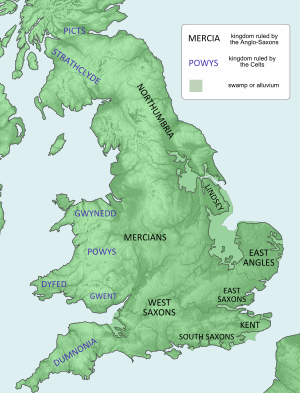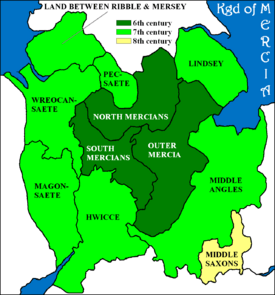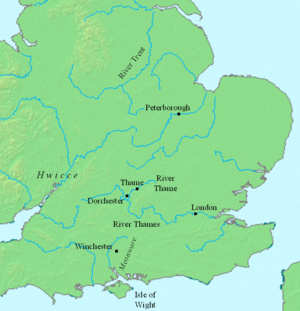Wulfhere of Mercia facts for kids
Quick facts for kids Wulfhere |
|
|---|---|
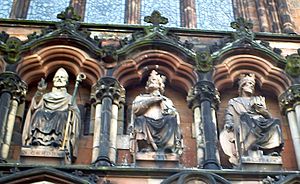
Depiction of Wulfhere on the right at Lichfield Cathedral.
|
|
| King of Mercia | |
| Reign | 658 – 675 AD |
| Predecessor | Peada |
| Successor | Æthelred |
| Born | c.640 AD |
| Died | 675 AD |
| Spouse | Eormenhild |
| Issue | Coenred Werburgh |
| Dynasty | Iclingas |
| Father | Penda |
| Mother | Cynewise (possibly) |
Wulfhere (died 675 AD) was a powerful king of Mercia from 658 to 675 AD. He was the first Christian king to rule all of Mercia. We don't know exactly when or how he became a Christian, as his family had followed Anglo-Saxon paganism.
Wulfhere's time as king marked the end of Oswiu of Northumbria's control over southern England. Wulfhere greatly expanded Mercia's power across the region. He led successful campaigns against the West Saxons, gaining control of much of the Thames Valley. He also conquered the Isle of Wight and the Meon valley, giving them to King Æthelwealh of the South Saxons. Wulfhere also had influence in Surrey, Essex, and Kent. He married Eormenhild, who was the daughter of King Eorcenberht of Kent.
Wulfhere's father, Penda, was killed in 655 AD at the Battle of Winwaed. He was fighting against Oswiu of Northumbria. Penda's son, Peada, became king under Oswiu's rule but died just six months later. Wulfhere became king in 658 AD when Mercian nobles rebelled against Northumbrian rule and forced Oswiu's governors out.
By 670 AD, when Oswiu died, Wulfhere was the strongest king in southern England. He was like an "overlord" for most of England south of the Humber River from the early 660s. However, he did not control Northumbria, unlike his father. In 674 AD, Wulfhere challenged Oswiu's son, Ecgfrith of Northumbria, but was defeated. Wulfhere died, probably from an illness, in 675 AD. His brother, Æthelred, became the next King of Mercia. A writer named Stephen of Ripon described Wulfhere as "a man of proud mind, and insatiable will."
Contents
Mercia in the 600s
In 600 AD, England was mostly ruled by the Anglo-Saxons. These people had come to Britain from northwestern Europe over the previous 200 years. A monk named Bede, who wrote in about 731 AD, believed the Mercians came from the Angles. The Saxons and Jutes settled in the south of Britain, while the Angles settled in the north.
We don't know much about how the kingdom of Mercia began. It was located in what is now the English Midlands. Early Mercian kings were said to be descended from Icel of Mercia. This family line is known as the Iclingas. The first Mercian king we have clear historical facts about is Penda of Mercia, Wulfhere's father.
Bede's book, Ecclesiastical History of the English People, talks about seven early Anglo-Saxon rulers. These rulers held imperium, meaning they had great power over other kingdoms. The fifth of these was Edwin of Northumbria. He was killed in the Battle of Hatfield Chase by a combined force. This force included Cadwallon ap Cadfan, a British king, and Penda. At the time of this victory, Penda was probably not yet king of Mercia. His children included Wulfhere and Æthelred, who both became kings of Mercia later.
After Edwin's death, Northumbria split into two kingdoms: Bernicia and Deira. A year later, Oswald killed Cadwallon and reunited the kingdoms. He then brought Northumbrian power back to southern England. However, on August 5, 642 AD, Penda killed Oswald at the Battle of Maserfield. This battle likely took place at Oswestry. Penda was not called an overlord of other southern Anglo-Saxon kings. But he became the most powerful Anglo-Saxon king after defeating Oswald. After Oswald's death, Northumbria was divided again. Oswald's son Oswiu became king of Bernicia. Osric's son Oswine became king of Deira, the southern kingdom.
The main source of information for this time is Bede's History. He finished it around 731 AD. Even though it focuses on church history, it gives important details about the early pagan kingdoms. For other kingdoms like Wessex and Kent, Bede had people who gave him information. This doesn't seem to be true for Mercia, so Bede's information about Mercia is less detailed. Another source is the Anglo-Saxon Chronicle. This was put together at the end of the 800s in Wessex. The person who wrote it seems to have used a lot of older records.
Becoming King and Gaining Power
In 655 AD, Penda attacked Oswiu of Northumbria at a place called Iudeu. Its exact location is unknown. Penda took Oswiu's son, Ecgfrith, as a hostage. Oswiu paid Penda a lot of treasure to make him leave. On his way back to Mercia, Oswiu caught up with Penda. On November 15, 655 AD, Oswiu and Penda fought by the River Winwaed. Penda was killed by Oswiu. Oswiu then split Mercia into northern and southern parts. The northern part was directly controlled by Northumbria. The southern part was given to Penda's son Peada. Peada had married Oswiu's daughter Ealhflæd around 653 AD.
Peada did not rule for long. He was killed in 656 AD. Oswiu then ruled all of Mercia himself. Bede lists Oswiu as the seventh and last king to hold imperium (or bretwalda) over the other Anglo-Saxon kingdoms. Being an "overlord" was common between kingdoms then. It meant a weaker king was under the control of a stronger one. Oswiu went further by putting his own governors in Mercia after Penda and Peada died.
This attempt to control Mercia closely failed in 658 AD. Three Mercian leaders, Immin, Eafa, and Eadbert, rebelled against the Northumbrians. Bede says they had kept Wulfhere hidden. When the revolt succeeded, Wulfhere became king. Some historians think the Mercian revolt worked because Oswiu might have been busy fighting in Pictland, in northern Britain. His nephew, the Pictish king Talorgan, had died in 657 AD.
It's not clear how much direct control Oswiu had over the southern kingdoms. Bede describes Oswiu's friendship with Sigeberht of the East Saxons. But generally, Oswiu's influence in the southeast was not very strong. Wulfhere seems to have taken over Oswiu's powerful position. Bede does not list Wulfhere as one of the rulers who held imperium. However, modern historians believe that Mercia's rise to power began during Wulfhere's reign. He was likely the main ruler of Britain south of the Humber River from the early 660s. But he was not an overlord of Northumbria, unlike his father.
A document called the Tribal Hidage might be from Wulfhere's reign. It lists the peoples of Anglo-Saxon England and how much land they had. This document was created before many smaller groups joined larger kingdoms like Mercia. It's hard to say exactly when the Tribal Hidage was written. It might have been during Wulfhere's reign. But other ideas include the reigns of Offa of Mercia, or Edwin or Oswiu of Northumbria.
A Christian King
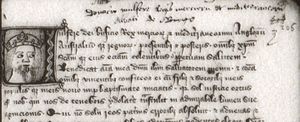
Britain had become Christian when the Romans ruled it. But the arriving Anglo-Saxons practiced their own religion (Anglo-Saxon paganism). The Christian church in Britain was limited to the remaining British kingdoms in Scotland, Wales, and Dumnonia. Missionaries from Rome began converting the Anglo-Saxons to Christianity in the late 500s. This process was well underway during Penda's reign, though Penda himself remained pagan. Records show other kings were baptized around this time. For example, Cynegils of Wessex was baptized around 640 AD, and Edwin of Northumbria converted in the mid-620s. However, some later kings, like Cædwalla of Wessex, were pagan when they became king.
Bede wrote that after Wulfhere became king: "Free under their own king, they [the Mercians] gave willing allegiance to Christ their true king, so that they might win his eternal kingdom in heaven." Wulfhere's father had refused to become Christian. Peada had seemingly converted to marry Oswiu's daughter. But we don't know when or how Wulfhere converted. Some think he became Christian as part of an agreement with Oswiu. Bede records that two years before Penda's death, his son Peada converted to Christianity. He was partly influenced by Oswiu's son Ealhfrith, who had married Peada's sister Cyneburh. Peada brought Christian missionaries into Mercia. It's possible Wulfhere became Christian then. Wulfhere's marriage to Eormenhild of Kent would have connected Mercia closely with the Christian kingdoms of Kent and Merovingian Gaul. These kingdoms were linked by family and trade. The political and economic benefits of the marriage might also have played a part in Wulfhere making his kingdom Christian.
Wulfhere's relationship with Bishop Wilfrid is written in Stephen of Ripon's Life of Wilfrid. From 667 to 669 AD, while Wilfrid was at Ripon, Wulfhere often invited him to Mercia when a bishop was needed. According to Stephen, Wulfhere gave Wilfrid "many tracts of land." In these lands, Wilfrid "soon established minsters for servants of God."
The Anglo-Saxon Chronicle says Wulfhere gave money and land to a large monastery at Medeshamstede, now called Peterborough. The monastery had first been given money by Peada. For Wulfhere's gift, Archbishop Deusdedit (died 664 AD) and Bishop Jaruman (who was bishop from 663 AD) were present. Wulfhere and Oswiu signed the gift document. So did Sigehere and Sæbbi, the Kings of Essex.
Controlling Other Kingdoms
In 661 AD, the Chronicle records Wulfhere attacking Ashdown, which was in West Saxon land. The Gewisse, who were the original group of West Saxons, first settled in the upper Thames valley. Records from the 500s show them active there. Mercia's return to power under Wulfhere put a lot of pressure on them. Also in the early 660s, the West Saxon church area of Dorchester was split. A new bishopric was set up at Winchester. This was likely because Mercia was moving into the West Saxons' main territory, making Dorchester too close to the border. Within a few years, the Dorchester area was no longer used. The exact date is unknown, but it was probably in the mid-660s.
Besides attacking Ashdown, Wulfhere raided the Isle of Wight in 661 AD. He then gave the island and the Meonware territory to his godson, King Æthelwealh of the South Saxons. The Meonware land was along the river Meon, north of the Isle of Wight. It seems the ruling family on the island accepted this to some extent. Later, the West Saxons, led by Cædwalla, killed the entire family when they attacked the island in 686 AD. After conquering the Isle of Wight, Wulfhere ordered a priest named Eoppa to baptize the people. The Chronicle says this was the first time Christian baptism reached the island.
In the early 670s, Cenwealh of Wessex died. Perhaps because of Wulfhere's military actions, the West Saxon kingdom broke apart. It was then ruled by smaller kings, according to Bede. Eventually, these smaller kings were defeated, and the kingdom was reunited. This was probably done by Cædwalla, or possibly by Centwine. Ten years after Wulfhere's death, the West Saxons under Cædwalla began to expand aggressively to the east. This reversed much of Mercia's earlier gains.
King Æthelwealh of the South Saxons was Wulfhere's godson. He also had a family link to the Mercians through marriage. His wife was Queen Eafe, the daughter of Eanfrith of the Hwicce. The Hwicce lived southwest of Mercia. They had their own royal family. But it seems they were already under Wulfhere's control at this time. The marriage between Æthelwealh and Eafe might have happened at Wulfhere's court. We know Æthelwealh became Christian there. The Hwicce kingdom is sometimes thought to have been created by Penda. But it's also possible it existed on its own. Penda and Wulfhere's growing influence in the area likely meant Mercian power was expanding, not that a new kingdom was being created.
East Anglia and the East Saxons
In 664 AD, Æthelwald of East Anglia died. Ealdwulf became king and ruled for fifty years. We know almost nothing about Mercia's relationship with East Anglia during this time. East Anglia had been controlled by Northumbria before. But there's no sign this continued after Wulfhere became king. Swithhelm of the East Saxons also died in 664 AD. His two sons, Sigehere and Sæbbi, became kings. Bede describes them as "rulers... under Wulfhere, king of the Mercians." A plague that same year caused Sigehere and his people to stop being Christian. According to Bede, Wulfhere sent Jaruman, the bishop of Lichfield, to convert the East Saxons back to Christianity. Jaruman was not the first bishop of Lichfield. Bede mentions a previous bishop, Trumhere, but we know nothing about him.
From these events, it's clear that Oswiu's influence in the south had weakened by this time. Wulfhere now controlled the area. This became even clearer in the next few years. Sometime between 665 and 668 AD, Wulfhere sold the church area of London to Wine. Wine had been forced out of his West Saxon bishopric by Cenwealh. London was part of the East Saxons' territory back then. From archaeological findings, it seems that around this time, the Middle Saxon settlement in London began to grow a lot. The center of Anglo-Saxon London was not in the old Roman center. It was about a mile west, near what is now the Strand. Wulfhere might have been in charge of the city when this growth started.
Kent, Surrey and Lindsey
Eorcenberht was the king of Kent when Wulfhere became king. The two families became connected when Wulfhere married Eorcenberht's daughter Eormenhild. In 664 AD, Eorcenberht's son Egbert became king of Kent. What happened in Kent after Egbert's death in 673 AD is not very clear. It seems a year passed before Hlothhere, Egbert's brother, became king. Wulfhere might have been interested in who became king. Through his marriage to Eormenhild, he was the uncle of Egbert's two sons, Eadric and Wihtred. Some historians think Wulfhere might have been the actual ruler of Kent during the time between Egbert's death and Hlothhere becoming king. Another Mercian connection to Kent was through Merewalh. He was the king of the Magonsæte, and therefore a sub-king under Wulfhere. Merewalh, who might have been Wulfhere's brother, was married to Hlothhere's sister, Eormenburh.
Surrey was never recorded as an independent kingdom. But it was a region controlled by different neighbors at different times. Egbert ruled it until the early 670s. A document shows Wulfhere confirming a gift given to Bishop Eorcenwald by Frithuwold. Frithuwold was a sub-king in Surrey. His territory might have reached north into modern Buckinghamshire. Frithuwold himself was probably married to Wilburh, Wulfhere's sister. The document, made from Thame, is dated between 673 and 675 AD. Egbert's death likely caused Wulfhere to get involved. A witness named Frithuric is on a document from Wulfhere's successor, Æthelred. This document gives land to the Peterborough monastery. The similar names in Anglo-Saxon royal families suggest these two men might have come from a Middle Anglian family. Wulfhere might have placed Frithuwold on the throne of Surrey. The document is witnessed by three other sub-kings: Osric, Wigheard, and Æthelwold. Their kingdoms are not named. But the document mentions Sonning, a region in what is now eastern Berkshire. This might mean one of these sub-kings ruled the Sunningas, the people of that region. This would also mean Wulfhere controlled that region by then.
Wulfhere's influence among the Lindesfara, whose land (Lindsey) was in what is now Lincolnshire, is known from church records. At least one of the Mercian bishops of Lichfield had power there. This was Wynfrith, who became bishop after Chad died in 672 AD. We also know that Wulfhere gave land at Barrow upon Humber, in Lindsey, to Chad for a monastery. It's possible Chad also had power there as bishop, probably by 669 AD. The political reason for Mercian church control of the Lindesfara might have been set early in Wulfhere's reign. This would have been under Trumhere and Jaruman, the two bishops before Chad.
Defeat and Death
When Wulfhere attacked Oswiu's son Ecgfrith in 674 AD, he was in a strong position. Stephen of Ripon's Life of Wilfrid says that Wulfhere "stirred up all the southern nations against [Northumbria]." Bede does not mention this fight, nor does the Anglo-Saxon Chronicle. But according to Stephen, Ecgfrith defeated Wulfhere. He forced Wulfhere to give up Lindsey and pay tribute.
Wulfhere survived the defeat. But he clearly lost some control over the south because of it. In 675 AD, Æscwine, one of the West Saxon kings, fought him at Biedanheafde. We don't know where this battle was, or who won. Henry of Huntingdon, a historian from the 1100s, had access to versions of the Anglo-Saxon Chronicle that are now lost. He believed the Mercians won a "terrible battle." He also noted that Wulfhere had inherited "the valour of his father and grandfather." However, historian Kirby thinks Æscwine was successful enough to break Wulfhere's control over Wessex.
Wulfhere died later in 675 AD. According to Henry of Huntingdon, he died from an illness. He would have been in his mid-thirties. His widow, Eormenhild, is thought to have later become the head nun of Ely. Æthelred, Wulfhere's brother, became king and ruled for almost thirty years. Æthelred got Lindsey back from the Northumbrians a few years after becoming king. But he generally could not keep the strong control over the south that Wulfhere had achieved.
Family
Wulfhere married Eormenhild (also called Ermenilda). She was a daughter of Eorcenberht, King of Kent. She outlived Wulfhere and is thought to have become the Abbess of Ely after his death. The earliest records don't mention children from their marriage. However, other sources list the following children:
- Coenred, King of Mercia from 704 to 709 AD. He is recorded as Wulfhere's son in John of Worcester's chronicle from the 1100s.
- Berhtwald, a sub-king who is recorded as a nephew of Æthelred.
- Werburh (also called Werburga), recorded in an 11th-century manuscript as a daughter of Wulfhere.
- Saint Wulfad, who was led by a white hart (a male deer) while hunting with his brother Ruffin. This led him to the hermitage of Saint Chad. Saint Chad converted Wulfad to Christianity.
- Ruffin, who also converted to Christianity.
See also
 In Spanish: Wulfhere de Mercia para niños
In Spanish: Wulfhere de Mercia para niños


